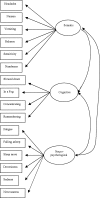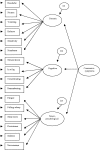Evidence for the Factorial and Construct Validity of a Self-Report Concussion Symptoms Scale
- PMID: 12937520
- PMCID: PMC164898
Evidence for the Factorial and Construct Validity of a Self-Report Concussion Symptoms Scale
Abstract
OBJECTIVE: To evaluate the factorial and construct validity of the Head Injury Scale (HIS) among a sample of male and female collegiate athletes. DESIGN AND SETTING: Using a cross-sectional design, we established the factorial validity of the HIS scale with confirmatory factor analysis and the construct validity of the HIS with Pearson product moment correlation analyses. Using an experimental design, we compared scores on the HIS between concussed and nonconcussed groups with a 2 (groups) x 5 (time) mixed-model analysis of variance. SUBJECTS: Participants (N = 279) in the cross-sectional analyses were predominately male (n = 223) collegiate athletes with a mean age of 19.49 +/- 1.63 years. Participants (N = 33) in the experimental analyses were concussed (n = 17) and nonconcussed control (n = 16) collegiate athletes with a mean age of 19.76 +/- 1.49 years. MEASUREMENTS: All participants completed baseline measures for the 16-item HIS, neuropsychological testing battery, and posturography. Concussed individuals and paired controls were evaluated on days 1, 2, 3, and 10 postinjury on the same testing battery. RESULTS: Confirmatory factor analysis indicated that a theoretically derived, 3-factor model provided a good but not excellent fit to the 16-item HIS. Hence, the 16-item HIS was modified on the basis of substantive arguments about item-content validity. The subsequent analysis indicated that the 3-factor model provided an excellent fit to the modified 9-item HIS. The 3 factors were best described by a single second-order factor: concussion symptoms. Scores from the 16-item HIS and 9-item HIS were strongly correlated, but there were few significant correlations between HIS scores and scores from the neuropsychological and balance measures. A significant group-by-day interaction was noted on both the 9-item HIS and 16-item HIS, with significant differences seen between groups on days 1 and 2 postconcussion. CONCLUSIONS: We provide evidence for the factorial and construct validity of the HIS among collegiate athletes. This scale might aid in return-to-play decisions by physicians and athletic trainers.
Figures




References
-
- American Academy of Neurology. Practice parameter: the management of concussion in sports [summary statement]. Report of the Quality Standards Subcommittee. Neurology. 1997;48:581–585. - PubMed
-
- Barth JT, Alves WM, Ryan TV, et al. Mild head injury in sports: neuropsychological sequelae and recovery of function. In: Levin HS, Eisenberg HA, Benton AL, editors. Mild Head Injury. New York, NY: Oxford University Press; 1989.
-
- Cantu RC. Return to play guidelines after a head injury. Clin Sports Med. 1998;17:45–60. - PubMed
-
- Roos R. Guidelines for managing concussion in sports: a persistent headache. Physician Sportsmed. 1996;24(10):31–46. - PubMed
LinkOut - more resources
Full Text Sources
